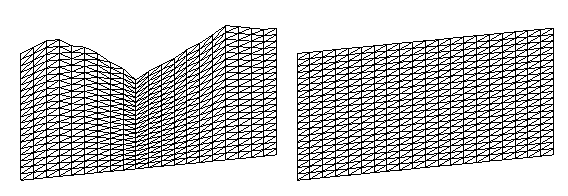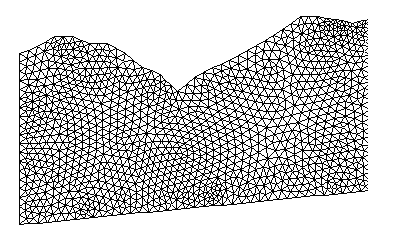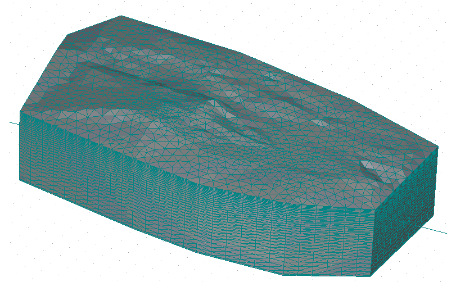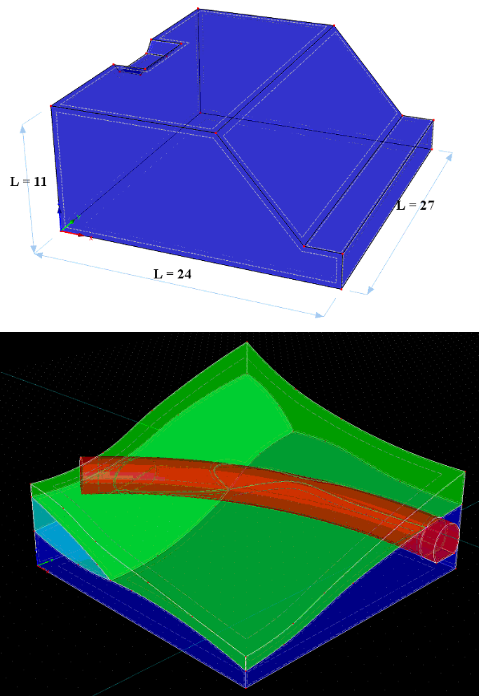Different Types of Geometry can be used in HYDRUS. Users can select between two-dimensional (2D) and three-dimensional (3D) Geometries. Two-dimensional geometries can be specified in the Horizontal or Vertical Plane, or can be radially symmetrical around the vertical axis (2D-Axisymmetrical). Three-dimensional Geometries can be either Layered (3D-Layered) or General (3D-General). One can additionally select between Simple Domains (Parametric Definition) or General Domains (Boundary Representation). Examples of various Geometries are given below. Geometry type is selected in the Domain Type and Units dialog window.
Simple Domains
The transport domain may be defined using relatively simple two-dimensional rectangular or three-dimensional hexahedral objects. In that case, the dimensions and other parameters of the transport domain are specified numerically using either the Rectangular or Hexahedral Domain Definition dialog windows. In both of these cases the transport domain is discretized into a structured finite element mesh.
General Domains
Alternatively, a more general geometry can be defined from one or more components - surfaces. Surfaces are formed by their boundary curves that can consist of any combination of polylines, arcs, circles or splines. The program also permits one to specify internal boundaries (e.g., drains, wells, impermeable objects), as well as internal curves and points. A user can define from these objects either a two-dimensional transport domain or the base plane (base surface) of the 3D-Layered domain which is then extruded to 3D with the help of thickness vectors. In both of these cases the transport domain is discretized into an unstructured finite element mesh.
In the 3D-Standard version (with 3D-Layered geometries), the Geometry is defined using the base surface, which is a 2D domain of an arbitrary shape, and a set of Thickness Vectors, that define the variable thickness of the 3D-Layered or thicknesses of an arbitrary number of Geo-Layers (called Sub-Layers in Version 1). Such domain is then called the 3D-Layered domain. Although such domains can not be fully general, they allow definition of a majority of realistic 3D problems.
In the 3D-Professional version (with 3D-General geometries), the Geometry can be formed from three-dimensional objects (Solids, bodies) of general shapes. Three-dimensional objects are formed by boundary surfaces, which can be either Planar surfaces or curved surfaces (Quadrangle, Rotary, Pipe, B-Spline). In more complicated cases it is also possible to use Intersections of surfaces and solids and to create in this way openings in solids or to carry out with solids logical operations.
1. An examples of Simple Rectangular Geometries:

2. An example of a General Two-Dimensional Geometry:

3. An example of a Simple Hexahedral Three-Dimensional Geometry:

4. An example of a Three-Dimensional Layered Geometry (developed from a Base Surface and a number of Thickness Vectors):

More information about the 3D-Layered Geometries.
5. Examples of a Three-Dimensional General Geometry:

More information about the 3D-General Geometries.
For 2D projects the computational domain can exist in:
Detailed definitions of different two- and three-dimensional domains is given below.
|
Rectangular |
Defined by boundary curves |
|
Hexahedral |
Defined by Base Surface and Thickness Vectors |
|
Defined using three-dimensional objects (Solids, bodies) of general shapes |
|
See also:
Back to HYDRUS Step by Step.